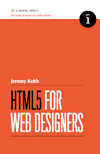Reading + Quiz
DUE Wednesday, Feb 08 – 5 points
(Thursday NOON deadline)
-
 A Brief History of Markup
A Brief History of Markup
The next version of HTML is HTML5, and it is currently in development. In the first chapter of his book HTML5 for Web Designers, Jeremy Keith gives a very good summary of the history of HTML that provides a good context for understanding what HTML5 is. This first chapter is available free online. (I highly recommend this book if you are interested in HTML5.) -
Banishing Your Inner Critic
This article by Denise Jacobs discusses what the inner critic is and how you can keep it from stifling your creativity and productivity.
All questions should be prefaced with an understood, “According to the author …”:
- T/F? The latest version of HTML, HTML5, is the most ambitious change to the language yet.
- T/F? The language defined by Tim Berners-Lee in the 1991 document titled “HTML Tags” contained less than 24 tags.
- T/F? HTML was the first language to use tags consisting of words in between angled brackets.
- T/F? HTML 1 is the name of the first version of the HTML specification, and it was published in 1991.
- T/F? The “X” in XHTML stood for “eXtreme.”
- T/F? XHTML 1.0 contained all the tags of HTML 4.01, plus it introduced more than ten new tags.
- T/F? Representative from browser-makers Opera, Apple, and Mozilla formed the WHATWG in 2004.
- T/F? In 2009, Sir Tim Berners-Lee wrote a blog post that moving the web from HTML to XML was the right approach.
- T/F? In 2009, the W3C announced that the charter for XHTML 2 would not be renewed.
- T/F? In 2022, websites will break unless they are rewritten in HTML5.
- T/F? Denise Jacobs describes the inner critic as a troll preventing good ideas from moving up from your subconscious into your conscious mind.
- T/F? Denise Jacobs mentions Jeffrey Zeldman and Lea Verou as examples of two people producing great tools or content.
- T/F? Denise Jacobs mentions Lanyrd as a website that pulls conference information from Twitter.
- T/F? Statements like “I should have” or “I could have” come from the inner critic.
- T/F? Denise Jacobs mentions a number of symptoms for “perfectionism,” including procrastination, the setting of unrealistic goals, fear of failure, and even fear of success.
- T/F? Denise Jacobs describes a person with “Impostor Syndrome” as someone who copies other people’s work when he has no original creative ideas.
- T/F? The goal of Denise Jacobs’ article is to help us ignore our inner critic completely.
- T/F? The inner critic is useful later in the creative process, for selecting from a number of iterations or editing a written piece of content.
- T/F? By “neuroplasticity,” Denise Jacobs refers to the brain’s ability to create new neural pathways in response to thinking different thoughts.
- T/F? One way to silence the inner critic is to raise your expectations of yourself, not settling for just “good” but striving to attain perfection.
DUE Wednesday, Feb 08 – 5 points
(Thursday NOON deadline)
